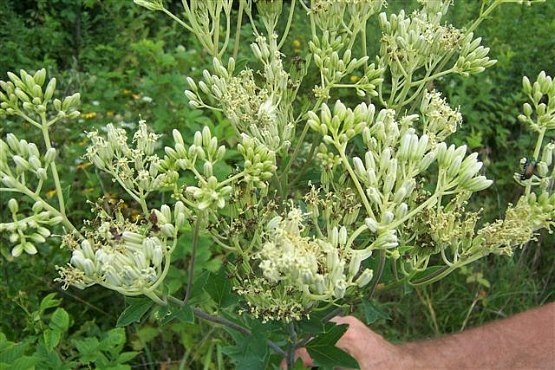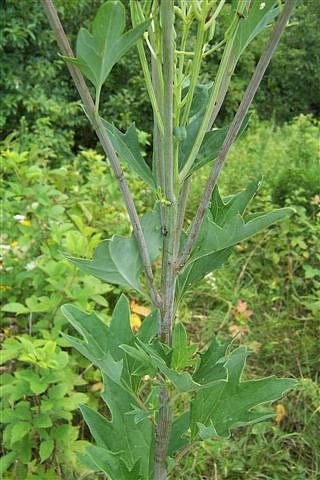Description: This perennial wildflower forms a rosette of basal leaves spanning up to 1' across. The basal leaves are up to 8" long and 6" across; they are oval-cordate or oval and their margins are undulate-angular to shallowly cleft. The petioles of the basal leaves are up to 6" long, light green, glabrous, and rather stout. The upper surfaces of the leaves are medium to dark green and glabrous, while their lower surfaces are pale greenish white to bright white. During the spring, an unbranched flowering stalk with alternate leaves develops; it becomes 3-9' tall. The central stalk is pale green to pale purple, terete, glabrous, and glaucous; fine longitudinal veins are often visible along this stalk. The alternate leaves are up to 8" long and 8" across, becoming gradually smaller as they ascend the central stalk. The leaves are mostly deltate-cordate, deltate-orbicular, or deltate-ovate; their margins are shallowly to moderately cleft with pointed lobes and to some extent undulate-angular. The upper and lower surfaces of the alternate leaves have the same characteristics as the basal leaves, and both types of leaves have palmate veins. The petioles along the central stalk are about as long as their leaves; they are light green and glabrous.

The central stalk
terminates in a flat-topped panicle (or compound corymb) of
flowerheads. The flowerheads are usually arranged in small clusters of
4-15 flowerheads. The branches of the panicle are light green and
glabrous. Individual flowerheads are about 1/8" (3 mm.) across and 1/3"
(8 mm.) long,
consisting of an involucre (base of the flowerhead) with 5 bracts in a
single series and 5 disk florets. In addition, there may be 2-3 tiny
bracteoles near the base of the flowerhead. Each disk floret has a
tubular corolla with 5 narrow lobes and an exerted bipartite style; the
corolla is cream-colored, greenish white, or pale purplish white. The
bracts of the involucre are linear-lanceolate, light green (sometimes
tinted purple), and glabrous. The blooming period occurs from
mid-summer to early fall and lasts about 1 month. Each fertile disk
floret produces an oblongoid achene with a tuft of white hair. The
achenes are distributed by the wind.
Cultivation:
The preference is full sun to light shade, moist to dry-mesic
conditions, and loamy, rocky, or sandy soil.
Range & Habitat:
The native Pale Indian Plantain is occasional throughout most of
Illinois, except
in the NW corner of the state, where it is largely absent (see Distribution
Map). Habitats include upland woodlands, rocky woodlands,
woodland borders, wooded slopes and slopes of ravines, woodland
openings, typical savannas and sandy savannas, typical thickets and
sandy thickets, partially shaded areas of sand dunes near Lake
Michigan, banks of streams, and prairies. Occasional wildfires and
removal of woody vegetation is probably beneficial in maintaining the
habitat of this wildflower.

Faunal
Associations:
In order to set fertile seed, the florets require cross-pollination by
insects. Such insect visitors are relatively few; they consist
primarily of wasps, flies, and small bees, which are attracted to
either the nectar or pollen. The larvae of a lizard beetle, Languria bicolor,
bore through the stems of Pale Indian Plantain (Vestal, 1913), while
the larvae of a moth, Phyllocnistis
insignis, are serpentine leaf-miners (Microleps website,
2010).
Photographic Location:
A prairie in Fayette County, Illinois. The photographs were taken by
Keith and Patty Horn (Copyright © 2009).
Comments:
Pale Indian Plantain can become quite tall. It has interesting foliage
that looks like it was made of plastic. Unlike other Arnoglossum
spp. (Indian Plantains) in Illinois, Pale Indian Plantain has
leaves with whitened undersides (varying from pale greenish white to
bright white). The common name, 'Indian Plantain,' refers to another
species in this genus that has plantain-shaped leaves. A scientific
synonym of Pale Indian Plantain is Cacalia atriplicifolia.